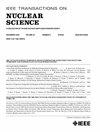Evaluation of Timing and Pulse Shape Analysis Method for the Measurement of Photoneutron Energy Distribution Using Commercially Available Digitizer
IF 1.9
3区 工程技术
Q3 ENGINEERING, ELECTRICAL & ELECTRONIC
引用次数: 0
Abstract
Photonuclear reactions triggered by high-energy photons are crucial in simulations for both nuclear physics and radiation transport. In such simulations, understanding the photonuclear reaction cross section and the energy distribution of secondary particles, particularly neutrons, is vital owing to the energy-dependent nature of neutrons. Experimental investigations have used monoenergetic, linearly polarized photons in the range of tens of MeV to measure neutron energy distributions resulting from photonuclear reactions. In an experiment, we adopted an electronic circuit and detector system based on the time-of-flight (ToF) method and particle identification to determine the energy distribution of emitted neutrons. This system required precise nanosecond-level timing and the ability to distinguish signals with millivolt-level differences. The advent of GHz sampling digitizers, field-programmable gate arrays (FPGAs), and high-speed interfaces allows these measurements to be conducted using commercially available single-board electronics. This study highlights the data acquisition (DAQ) process using a 1-GHz sampling rate, 14-bit resolution, FPGA-based real-time signal processing, and 1-MHz throughput digitizer (APV8104 by TechnoAP Company). Moreover, it provides a detailed description of the motivation behind the study, underscoring the importance of the energy spectrum. We evaluated the digitized data for their applicability and analyzed the raw data for potential improvements in timing and signal differentiation compared to those of traditional FPGA-based schemes.评估使用市售数字转换器测量光中子能量分布的定时和脉冲形状分析方法
高能光子引发的光核反应在核物理和辐射传输模拟中都至关重要。在此类模拟中,由于中子的能量依赖性,了解光核反应截面和二次粒子(尤其是中子)的能量分布至关重要。实验研究使用了几十兆电子伏范围内的单能量线性偏振光子来测量光核反应产生的中子能量分布。在一项实验中,我们采用了基于飞行时间(ToF)方法和粒子识别的电子电路和探测器系统来确定发射中子的能量分布。该系统要求精确的纳秒级计时,并能分辨毫伏级差异的信号。GHz 采样数字转换器、现场可编程门阵列 (FPGA) 和高速接口的出现,使得这些测量可以使用市面上的单板电子设备进行。本研究重点介绍了使用 1 GHz 采样率、14 位分辨率、基于 FPGA 的实时信号处理和 1-MHz 吞吐量数字转换器(TechnoAP 公司的 APV8104)的数据采集 (DAQ) 过程。此外,它还详细描述了研究的动机,强调了能谱的重要性。我们对数字化数据的适用性进行了评估,并对原始数据进行了分析,以发现与基于 FPGA 的传统方案相比,在定时和信号区分方面可能存在的改进。
本文章由计算机程序翻译,如有差异,请以英文原文为准。
求助全文
约1分钟内获得全文
求助全文
来源期刊

IEEE Transactions on Nuclear Science
工程技术-工程:电子与电气
CiteScore
3.70
自引率
27.80%
发文量
314
审稿时长
6.2 months
期刊介绍:
The IEEE Transactions on Nuclear Science is a publication of the IEEE Nuclear and Plasma Sciences Society. It is viewed as the primary source of technical information in many of the areas it covers. As judged by JCR impact factor, TNS consistently ranks in the top five journals in the category of Nuclear Science & Technology. It has one of the higher immediacy indices, indicating that the information it publishes is viewed as timely, and has a relatively long citation half-life, indicating that the published information also is viewed as valuable for a number of years.
The IEEE Transactions on Nuclear Science is published bimonthly. Its scope includes all aspects of the theory and application of nuclear science and engineering. It focuses on instrumentation for the detection and measurement of ionizing radiation; particle accelerators and their controls; nuclear medicine and its application; effects of radiation on materials, components, and systems; reactor instrumentation and controls; and measurement of radiation in space.
 求助内容:
求助内容: 应助结果提醒方式:
应助结果提醒方式:


